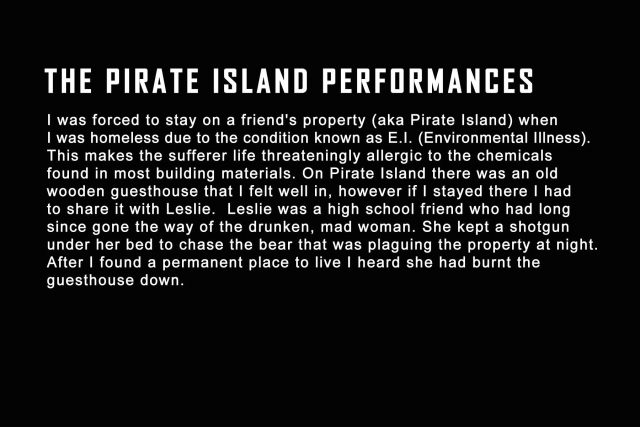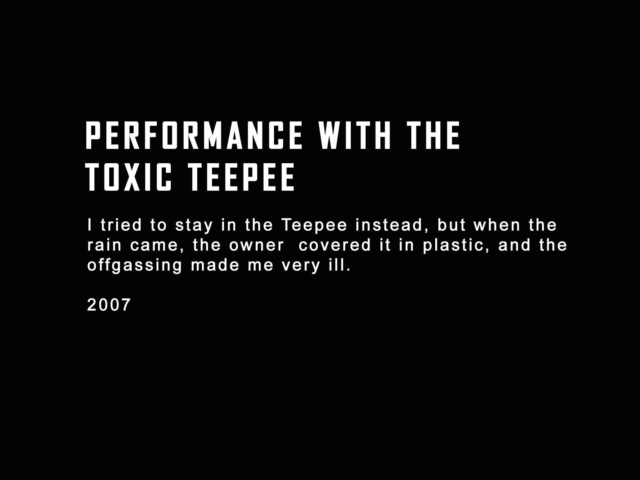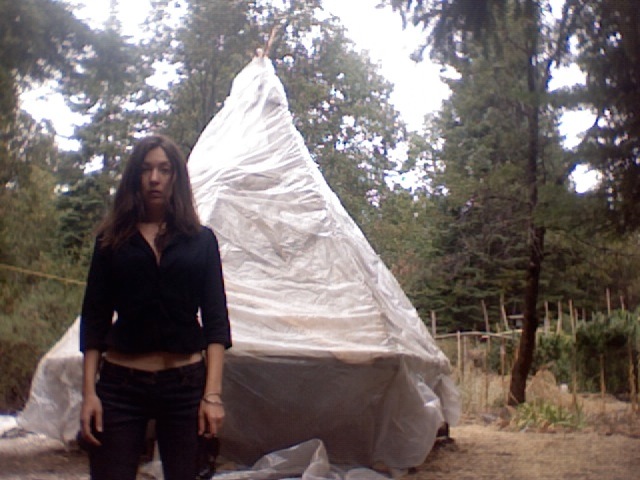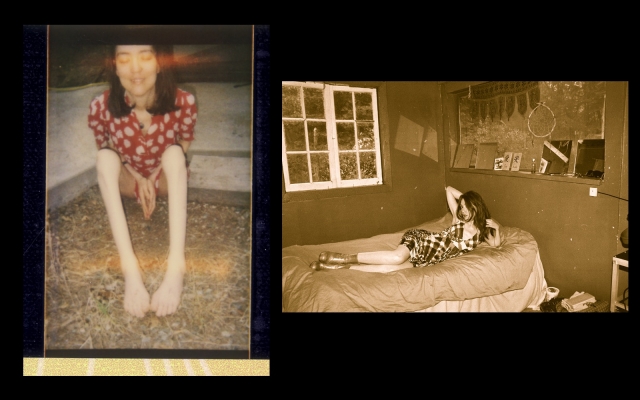2017
framing real life events as a performance
captured as a color photographic self portrait and essay
published in a curated art catalog Dynamism in hard copy and digital. Click image to see whole magazine.
The CASUALTIES OF CAPITALISM’S COMMERCE of TOXIC SUBSTANCES
(framing real life events as performance art)
essay by Monet Clark
In viewing the Pirate Island Performance Series one is delivered squarely into the dystopian reality of the ‘canary in the coal mine’ phenomenon, experienced by people like myself, who have Environmental Illness aka Multiple Chemical Sensitivity (MCS) 1,2 These pieces depict life on the fringes of a society in denial about the increasing toxicity of the world. Along with my Poisoning/Phoenix Performance Documents series and my performance/video movie BUNNY GIRL, this series confronts the politics, which sweep toxic contamination under the rug. 3, 4 These works expose us to the casualties of capitalism’s commerce of toxic substances. They show the people (and animals, in BUNNY GIRL), which are treated as expendable to market gains. I’ve often made pieces, which conceptually frame real life events as performances. I document these with either video, or a still camera. The Pirate Island Performances use this methodology and were made during a specific chapter in my long personal history with Environmental Illness and the corresponding trouble it presents in finding ‘safe’ non-toxic housing. I made these works with the foreknowledge that the personal is political.
The context for these works lies within the politics surrounding diseases caused by toxic exposures. It is estimated that 36.5 million people suffer from Environmental Illness aka MCS, in 2003 and this number has rapidly accelerated in the last two decades and continues to rise. 5 Sufferer’s immune systems and detoxification organs are no longer responding normally to even tiny amounts of toxic materials. This is often precipitated by either one large toxic exposure, or a sustained toxic exposure over time. Despite well documented clusters of people having developed the disease, it remains a politicized subject and is usually met with denial by the medical establishment.
New genetic tests now show a gene that is responsible for the methylation of toxins that sufferers of Environmental Illness aka MCS, commonly do not have. 6 Without this gene, concentrations of toxins build up in a person’s bloodstream instead of being broken down and eliminated from the body, which can lead to the disease. Some people who develop Environmental Illness also have a pathogenic load that is burdening their immune systems, like chronic Lyme Disease, and 60% of people with the neuro-immune disease Chronic Fatigue Syndrome also have Environmental Illness.7 Another causative factor in developing Environmental Illness can be a history of significant chronic stress or having experienced one major stressful event, coupled with a toxic exposure. Significant stress taxes the same ‘fight or flight’ adrenal gland response that toxic exposure also taxes, and both adversely impact the immune system. A history such as growing up in an abusive environment, or a single event such as surviving a natural disaster, could both put one at risk for developing the disease when followed by a significant toxic exposure. For example, a large cluster of people who survived the terrifying flooding of 2005’s hurricane Katrina, developed Environmental Illness aka MCS after being given emergency trailers from FEMA with formaldehyde levels 75 times the recommended threshold for workplace safety.8,9 FEMA’s efforts to supply the large demand for emergency structures caused them to use buildings that were quickly assembled and not given proper time to cure and off-gas, which would have reduced their toxicity. (After this event, FEMA initiated a contest calling upon the non-toxic architectural community to design inexpensive healthy structures that could meet future demands for quick assembly. The contest was won by an architect building with an inert and naturally mold and fire resistant board made of magnesium oxide).
The hurricane Katrina/FEMA building victims garnered much governmental recognition and medical validation. In other well documented cases the disease has been referred to as Sick Building Syndrome in several incidents when new office buildings made entire work forces within them ill, from high concentrations of off-gassing toxic building materials. 10 Another manifestation of the disease is Gulf War Syndrome where combat stress coupled with heavy toxic exposure left Gulf War solider’s immune systems, detoxification and stress organs, terribly compromised. 11 However, despite these examples and more, we remain a society collectively in denial regarding the health risks of toxic materials. The idea that there are people who are seriously ill from the toxic substances found all around us, in our tap water, our air, in our homes, and in everyday products, is taboo. Yet, everything from household cleaning products, air fresheners and dryer sheets, to skin care products, to particle board and the fire retardants in drywall, to textile manufacturing chemicals, to pesticides and petroleum products, contain toxic substances and the list goes on. Commonly the sentiment is that ‘its just a little bit, and a little won’t hurt you’. However we are getting ‘just a little bit’ most everywhere we go and if one has had more significant exposures, a little more becomes too much. Scientific studies show the health risks of many toxic substances that are still found in products offered to the consumer, but corporate profits are often prioritized over public health, as is the capitalistic economic model in general. Meanwhile diseases such as cancer, and these neuro-immune conditions and many more, are all too common. It is estimated that pollution both inside and outside the home is responsible for 12.6 million deaths each year. 12
People with Environmental Illness are the ‘canaries in the coal mine’ warning all of us that we are rapidly ruining the very environment needed to sustain our own lives. They should be treated like people with any disability, compassionately and the most compassionate thing one can do for a person with Environmental Illness is believe them. Scientific research is needed to combat the disease, and physicians should be trained so that they know how to recognize and care for people with Environmental Illness. Sufferers should be treated with dignity, instead of what is often the case, not taken seriously by doctors, family nor friends.
It is exceedingly difficult for people like me who have already developed the hyper-reactivity of Environmental Illness, to find housing. Paint, laminate floors, carpeting, drywall, caulking, insulation, wood finishes, these all have toxic materials that outgas for years, and the list goes on. Further old houses can also be problematic due to disintegrating materials such as brick dust, synthetic carpet and padding particulates, or mold growth, and this list too goes on. Staying inside a of a dwelling which aggravates the condition can advance the neuro-immune symptoms of the disease, cause weakness, as well as render the sufferer even more reactive to even more materials, and in some cases can lead to life threatening symptoms. I’m currently sleeping outside of a house I just rented, because as it turns out, it has mold and some other issues, which have exacerbated my condition further. In order for a person with Environmental Illness to stabilize their health, they must first and foremost, find accommodations that don’t aggravate their symptoms. Once this is created or found, then they can start to regain their strength and work towards detoxification treatments to get better. With the right housing and treatment, many people with Environmental Illness aka MCS can significantly improve. Given that most places have outgassing, housing is hard to find. Creative solutions must be sought, thus my brush with Pirate Island in the past, and my Opus Externus Domicilium in the present.
1,2 http://monetclark.com/performance-with-toxic-tee-pee/ http://bcn.boulder.co.us/health/rmeha/rmehdefn.htm
3,4 http://monetclark.com/poisoningphoenix-performance-documents/ http://monetclark.com/bunny-girl/
5 https://www.mcs-aware.org/home/what-is-mcs
6 https://maskedcanaries.wordpress.com/mcs/mthfr-gene-mutation/
7 https://www.fibrodaze.com/multiple-chemical-sensitivity/
8,9 http://www.wtv-zone.com/infchoice/toxic_trailers.html
http://www.washingtonpost.com/wp-dyn/content/article/2007/07/19/AR2007071901039.html
10 https://www.epa.gov/sites/production/files/2014-08/documents/sick_building_factsheet.pdf
11 http://www.ei-resource.org/illness-information/environmental-illnesses/gulf-war-syndrome/
12 http://www.who.int/mediacentre/news/releases/2016/deaths-attributable-to-unhealthy-environments/en/







